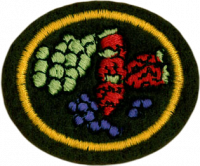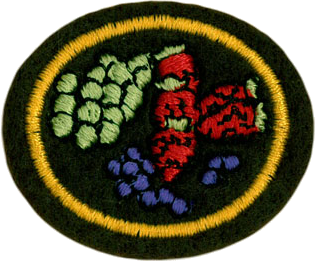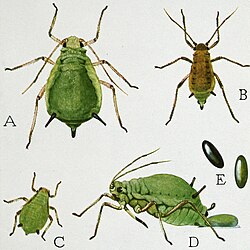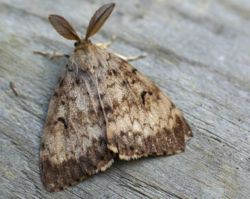AY Honors/Small Fruit Growing/Answer Key
1
- Bramble Berries: These include blackberries and raspberries. Brambles require loamy soil with a lot of organic matter mixed in with it. They will not tolerate sandy soil, or heavy soil that leaves moisture standing on the roots. A heavy layer of mulch will help the soil retain water and keep weeds down.
- Strawberries: Strawberries need well-worked soil with good drainage and plenty of organic material mixed in with it.
- Grapes: Grapes require fertile, well-drained soil. It should be mixed with plenty of compost, but be careful to not over-fertilize.
- Blueberries: Blueberries require soil that is well-drained and porous. It should also have lots of organic material in it, and it should be acidic with a pH between 4.5 and 5.5. A heavy layer of mulch will help the soil retain water and keep weeds down.
2
2a
The main thing to consider when selecting a variety is whether it is well-suited to the climate in which it will grow. Check that the variety will grow in your hardiness zone. The hardiness zone is a number from 1 to 11, with 1 indicating a cold climate, and 11 indicating a warm one. Many seed packages and seed catalogs have a map showing the hardiness zones. Make sure the variety of plant you select is suited for your zone number or higher.
The next thing to consider is the area you intend to plant the variety. Some are more suited to shade, and others require lots of sun. Varieties are also suited to different soil pH (which you can control). Finally, you should consider other factors, such as fruit size, yield, thornless stems, when the fruit is expected to ripen etc. It is also a good idea to plant multiple varieties. This can improve disease resistance and stagger the harvest times.
2b
2c
2d
2e
Blackberries and Raspberries
Blackberries and raspberries produces canes that live for two years. A first year cane is called a primocane and a second year cane is called a florocane. In most varieties, only the florocanes produce fruit. Once they produce fruit, they die. Florocanes should be pruned to the soil line as soon as they are harvested to eliminate an important path to disease. Primocanes should be pruned in to a height of 18-20 inches (45-50 cm). This will cause them to send out branches which will bear more fruit. The branches should be pruned to a length of about 12 inches (30 cm).
Blueberries
Blueberries should not be pruned for the first three years. After that, you should prune every year during the dormant period, removing any of the lower branches that look weak or are less than six inches (15 cm) long. Remove any branches longer than two inches (5 cm) in diameter (small branches bear larger fruit), and remove a portion of the branches in the center of the plant to allow sunlight to penetrate. Ideally, you should have about twelve canes per plant, and these should be of different ages.
Strawberries
During the first season, remove all blossoms so that the plant puts its energy into building its root system. A healthy strawberry plant will send out runners every year, and these will take root if not dealt with. For large berries, do not let these take root, but prune them off instead. Allow four or five runners to grow into a matted row no wider than 24 inches (60 cm), and trim off any runners that exceed the row boundaries. Berries are harvested during the second and third years. After that, they should be plowed under and new plants should be started.
Grapes
Before planting grapes, you should set up a two-wire trellis. This is simply two wires stretched horizontally, one above the other. The lower wire should be 30 inches (75 cm) from the ground, and the upper should be 60 inches (150 cm) from the ground. The grapes are planted below the wires and all except the best looking cane are removed. The remaining cane should be pruned such that only two buds are left. Don't be afraid to prune grapes - they are vigorous and very forgiving.
During the late winter of the second year, you should again remove all but the best looking canes. If this cane is higher than the top wire, cut it at that height and tie it tautly to the wire. If it is not higher than the top wire, prune it to two buds and tie it to the lower wire. If it is not higher than the lower wire, prune as if it were a first-year cane.
During the late winter of the third year, you should remove all but two of the best canes. Shorten the two remaining canes so that only four buds remain.
During the fourth year and beyond, you should have two canes per wire, each trained to go in a different direction. Remove all other canes, keeping the four that originate close to the trunk, and shortening them to six to eight buds each. Eliminate all other growth.
2f
During the early months of the growing season, the soil should be kept moist, but not soggy. Once the fruit is harvested, the plants should be watered less frequently, but with a good soaking. Remove any furrows or low spots before winter so that water is not allowed to stand around the plant and induce rot.
2g
When chemical pesticides were first introduced, they were used to the exclusion of all other types of pest control. This had the unfortunate effect of poisoning the environment. In the 1970's this situation was recognized, and Integrated Pest Management (IPM) techniques were introduced. Pesticides are still used, but they are a last resort.
When most people think of pests, they think of insects. In small fruit cultivation, this term should be expanded to include weeds, microorganisms, and mites. Pest control depends on the early and correct identification of the pest. The grower can use cultural mechanical, biological, or chemical controls to reduce the effect of pests on small fruit. These methods all rely on constant vigilance by the grower.
Cultural Controls include the selection of disease and pest-resistant cultivars. Crop rotation is another important cultural control, as certain pests feed exclusively on one type of plant. Eliminating the plant from the environment for a year or two will disrupt that cycle. Another important control mechanism is to mulch, water, prune, and fertilize the plants correctly. A healthy plant is better able to defend itself from pests.
Mechanical Controls include covering the plants with netting or setting traps for expected (or observed) pests. Pests can also be removed with vacuums or by hand. Hoeing and cultivating around the plants will help control weeds. It is also important to prune diseased canes or remove infected plants from the crop as soon as possible so that the disease does not spread.
Biological Controls include the introduction of natural predators. For instance, ladybug beetles feast on aphids, and poultry feed on a number of insect pests. Be careful when introducing predators though, that you do not introduce a non-native species which has no natural enemies of its own. This can - and has caused its own form of environmental damage. You can also use commercially available pheromones to disrupt the mating cycle of many insects.
Chemical Controls can be used when all else fails. Selection of a pesticide will depend on the particular pest being combated (which his why proper identification is so important). Sprays are generally more effective than dusts, as nearly all pesticides rely on contact with the pest for their effectiveness. Read the instructions on the chemical containers carefully before using, especially noting whether the chemical is safe to use on food plants. Many times a pesticide will warn against its use for a period of time before harvesting.
2h
Taste test a few blueberries and grapes before harvesting. It is difficult to tell if they are fully ripe by the color alone. Blackberries should be completely black before they are picked. Raspberries are ready when the berries separate from the plant easily. Strawberries should be picked daily until they quit producing. They are ripe when less than 25% of the berry is pink or white. Strawberries that are 25% white will be ripe the next day.
Place harvested fruits in small shallow baskets. Deep buckets will cause the berries to become crushed and unmarketable.
3
In North America hardiness zones map can be used as a guideline for categorizing locations suitable for growing a particular annual plant variety. Consult a nursery catalog to select an appropriate cultivar for your area. Many catalogs are availabe online:
We interpret the "each fruit" phrase of this requirement to be limited to the types listed in requirement 1, namely, brambles, blueberries, strawberries, and grapes.
4
See the section on pruning in requirement 2e for instruction.
5
A perishable crop is one that must be harvested and used (or preserved) in a timely manner or the produce will spoil. All small fruits fall in this category.
By way of counter-example, a non-perishable crop would include cereals, corn, and cotton.
6
Once harvested all small fruit should either be used immediately or refrigerated. Small fruit will spoil in less than a day without refrigeration. It is best to refrigerate berries at 30°F (-1°C). Berries will not freeze at that temperature because of the sugars inside. It is also crucial to refrigerate at a high humidity; 90-95% RH is ideal. If properly refrigerated, bramble berries will last up to seven days, blueberries up to three weeks, and strawberries up to a month.
7
Pests affecting all small fruit
The tarnished plant bug (TPB) is one of the most serious pests of small fruits and vegetables in New England. No truly effective or reliable management options currently exist. Growers routinely make 3-5 applications of insecticides each year to control this insect. The cost is $200-$500/acre. Considering the narrow profit margin for today's farmers, these costs are significant. The research being conducted at the Entomology Research Laboratory represents the first step towards developing insect-killing fungi for management of TPB. These pests are active from April or May until the first heavy frost of the year. TPB can be controlled by keeping weeds down.
Bramble Berry Pests
Aphids, also known as greenfly/blackfly or plant lice, are minute plant-feeding insects. Aphids are distributed world-wide, but they are most common in temperate zones. It is possible for aphids to migrate great distances depending on the weather patterns (mainly passive dispersal riding on winds). Look for aphids in late spring and early summer, especially on the underside of the leaves near the tips of the canes. If more than two aphids per cane are found, treat with a pesticide. Aphids overwinter on brambles, so when you prune, be sure to destroy the clippings.
Picnic beetles are small (5–12 mm) ovoid, usually dull-coloured beetles, with knobbed antennae. Some have red or yellow spots or bands. They feed mainly on decaying vegetable matter, over-ripe fruit, and sap. Picnic beetles become active when the temperature rises above 60°F (15°C). Cultural controls are effective because these pests live near the ground. Keep berries off the ground and pick them promptly. You can also trap them by placing overripe fruit in buckets away from the plants.
Leafhoppers have piercing sucking mouthparts, they feed on plant sap and can transmit plant viruses. Species that are significant agricultural pests include the potato leafhopper, beet leafhopper, white apple leafhopper, two-spotted leafhopper, and glassy-winged sharpshooter. Leafhoppers migrate into the central and northern US in the spring. Plants should be checked frequently in early summer and if signs of leafhopper are detected, the use of a pesticide is justified.
Blueberry Pests
The Plum curculio is a beetle native to the regions east of the Rocky Mountains in the United States and Canada. It is notorious for destroying fruits if left uncontrolled. The larvae bore into the blueberries causing them to drop off the plant and reduce the yield. Adults become active in the spring about the time the cultivars begin to bloom. Plum curculio are attracted to fruit trees, so if possible, do not plant blueberries near fruit trees. Otherwise, apply insecticide when the blossoms fall off and again ten days later.
The gypsy moth was introduced into the United States in 1868 by a French scientist, Leopold Trouvelot, living in Medford, Massachusetts, who enjoyed raising many types of caterpillars including silkworms. It is now one of the most notorious pests of hardwood trees in the Eastern United States. The first outbreak there occurred in 1889. By 1987, the gypsy moth had established itself throughout the Northeast USA and southern Quebec and Ontario. When gypsy moths feed on blueberry plants, they eat the leaves and buds. Bud loss leads to fruit loss. The eggs hatch in April or May and the larvae feed on the blueberry plants until early July. The larvae can be removed by hand in May and June, and the egg masses can be scraped from the bushes in the winter.
Strawberry Pests
Spider mites are extremely small, barely visible with the naked eye as reddish or greenish spots on leaves and stems; the adults measure about 0.5 mm. The red spider mite is extremely versatile; it can feed on hundreds of plants, including most vegetables and food crops (peppers, tomatoes, potatoes, beans, corn, strawberries) and ornamentals: roses, etc. It lays its eggs on the leaves, and it poses a threat to host plants by sucking cell contents from the leaves cell by cell, leaving very tiny, pale spots or scars. Spider mites are active through the warm months. The best way to control them is by reducing the use of pesticide which destroys their natural predators. Lady bugs and lacewings are particularly effective against spider mites, and some mites that prey on spider mites are commercially available. There is very little in the way of chemical controls available against spider mites. Spraying with a moderately high-pressure water hose can reduce the populations.
Grape Pests
The Japanese beetle (Popillia japonica) is a beetle about 1.5 cm (0.6 inches) long and 1 cm (0.4 inches) wide (smaller in Canada). It is not very destructive in Japan, where it is controlled by natural enemies, but in America it is a serious pest to rose bushes, grapes, crape myrtles, and other plants. It is a weak flyer and drops several centimeters when it hits a wall. Japanese beetle traps therefore consist of a pair of crossed walls with a bag underneath, and are baited with floral scent, pheromone, or both.
These insects damage plants by eating the surface material, leaving the veins in place, producing a curious — but alarming to the experienced gardener — sort of "transparent leaf" effect on its victims. Adults emerge in late June.
8
Soil testing kits are available at garden centers or over the Internet:
You can also have your soil tested for a small fee by a university or county extension service (see your local phone book white pages under "county government").
Once you have tested your soil, you'll need to find someone to give a fertilizer recommendation. The best place to do that would be at a nursery that sells small fruit plants. If the staff seems clueless, try another nursery.




